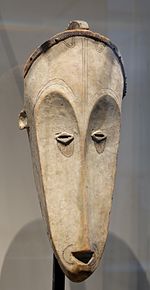Traditional African masks: Difference between revisions
m Reverting possible vandalism by 99.232.240.234 to version by RashersTierney. False positive? Report it. Thanks, ClueBot. (560580) (Bot) |
|||
| Line 31: | Line 31: | ||
[[it:Maschere tradizionali africane]] |
[[it:Maschere tradizionali africane]] |
||
[[vec:Mascare africane]] |
[[vec:Mascare africane]] |
||
the test ook.com |
|||
Revision as of 13:41, 8 March 2010


There are an enormous variety of masks used in Africa. In West Africa, masks are used in masquerades that form part of religious ceremonies enacted to contact with spirits and ancestors.
The Yoruba, Igbo and Edo cultures, including Egungun Masquerades and Northern Edo Masquerades. The masks are usually carved with an extraordinary skill and variety by artists who will usually have received their training as an apprentice to a master carver - frequently it is a tradition that has been passed down within a family through many generations. Such an artist holds a respected position in tribal society because of the work that he/she creates, embodying not only complex craft techniques but also spiritual/social and symbolic knowledge.[1] African masks are also used in the Mas or Masquerade of the Caribbean Carnival.

African masks are made from different materials: wood, bronze, brass, copper, ivory, terra cotta and glazed pottery, raffia and textiles. Some African masks are colourful. Many African masks represent animals. Some African tribes believe that the animal masks can help them communicate with the spirits who live in forests or open savannas. People of Burkina Faso known as the Bwa and Nuna call to the spirit to stop destruction. The Dogon of Mali have complex religions that also have animal masks. Their beliefs are in three main cults - the Awa, cult of the dead, Bini, cult of communication with spirits and Lebe, cult of earth and nature. These three main cults nevertheless use seventy-eight different types of masks. Most of the ceremonies of the Dogon culture are secret, although the antelope dance is shown to non-Dogons. The antelope masks are rough rectangular boxes with several horns coming out of the top. The Dogons are expert agriculturists and the antelope symbolizes a hard working farmer. [2]
Another culture that has a very rich agricultural tradition is the Bamana people of Mali. The antelope (called Chiwara) is believed to have taught man the secrets of agriculture. Although the Dogons and Bamana people both believe the antelope symbolises agriculture, they interpret elements the masks differently. To the Bamana people, swords represent the sprouting of grain.
Masks may also indicate a culture’s ideal of feminine beauty. The masks of Punu of Gabon have highly arched eyebrows, almost almond-shaped eyes and a narrow chin. The raised strip running from both sides of the nose to the ears represent jewelery. Dark black hairstyle, tops the mask off. The whiteness of the face represent the whiteness and beauty of the spirit world. Only men wear the masks and perform the dances with high stilts despite them being “lady” masks. One of the most beautiful representations of female beauty is the Idia’s Mask of Benin. It is believed to have been commissioned by a king of Benin in memory of his mother. To honor his dead mother, the king wore the mask on his hip during special ceremonies.[3]
The Senoufo people of the Ivory Coast represent tranquility by making masks with eyes half-shut and lines drawn near the mouth. The Temne of Sierra Leone use masks with small eyes and mouths to represent humility and humbleness. They represent wisdom by making bulging forehead. Other masks that have exaggerated long faces and broad foreheads symbolize the soberness of one’s duty that comes with power. War masks are also popular. The Grebo of the Ivory Coast carve masks with round eyes to represent alertness and anger, with the straight nose to represent unwillingness to retreat.[4]
Today, the qualities of African art are beginning to be more understood and appreciated. However most African masks are now being produced for the tourist trade. Although they often show skilled craftsmanship they will nearly always lack the spiritual character of the traditional tribal masks.
See also
References
- ^ Masks:Their Meaning and Function: Andreas Lommel pub. Ferndale Editions London orig. Atlantis Verlag Zurich 1970 — introduction, after Himmelheber Afrikanische Masken ISBN 0-905746-11-2
- ^ Faces of the Spirits.
- ^ Bortolot, Alexander Ives. "Idia: The First Queen Mother of Benin". In Timeline of Art History. New York: The Metropolitan Museum of Art, October 2003. Retrieved 25 March 2007.
- ^ African mask symbolism.
the test ook.com
